Study boltzman distribution function for ideal gas system
Abstract: Consider an ideal gas system consisting of a large number of particles. The nature
of the macroscopic system could not be described in detail. It could only be described in terms
of averages, i.e. only the mean values of the thermodynamic quantities characteristic of the
medium of the macro system. The average values of the thermodynamic quantities
characterizing the macroscopic state of the system such as state equation, free energy, the
internal energy, etc. could be calculated by Boltzman distribution function.
Keywords: Ideal gas, distribution function, the average quantities, Boltzman distribution
function.
1. Introduction
An ideal gas system consisting of an extremely large number of particles could not be
mechanically studied but could only be studied by statistical methods. The gas system here is
considered as a homogeneous particle system. The Boltzmann distribution function is derived
based on the application of the Gibss distribution function to the homogeneous particle
system, through that it could describe the average nature of the ideal gas system.
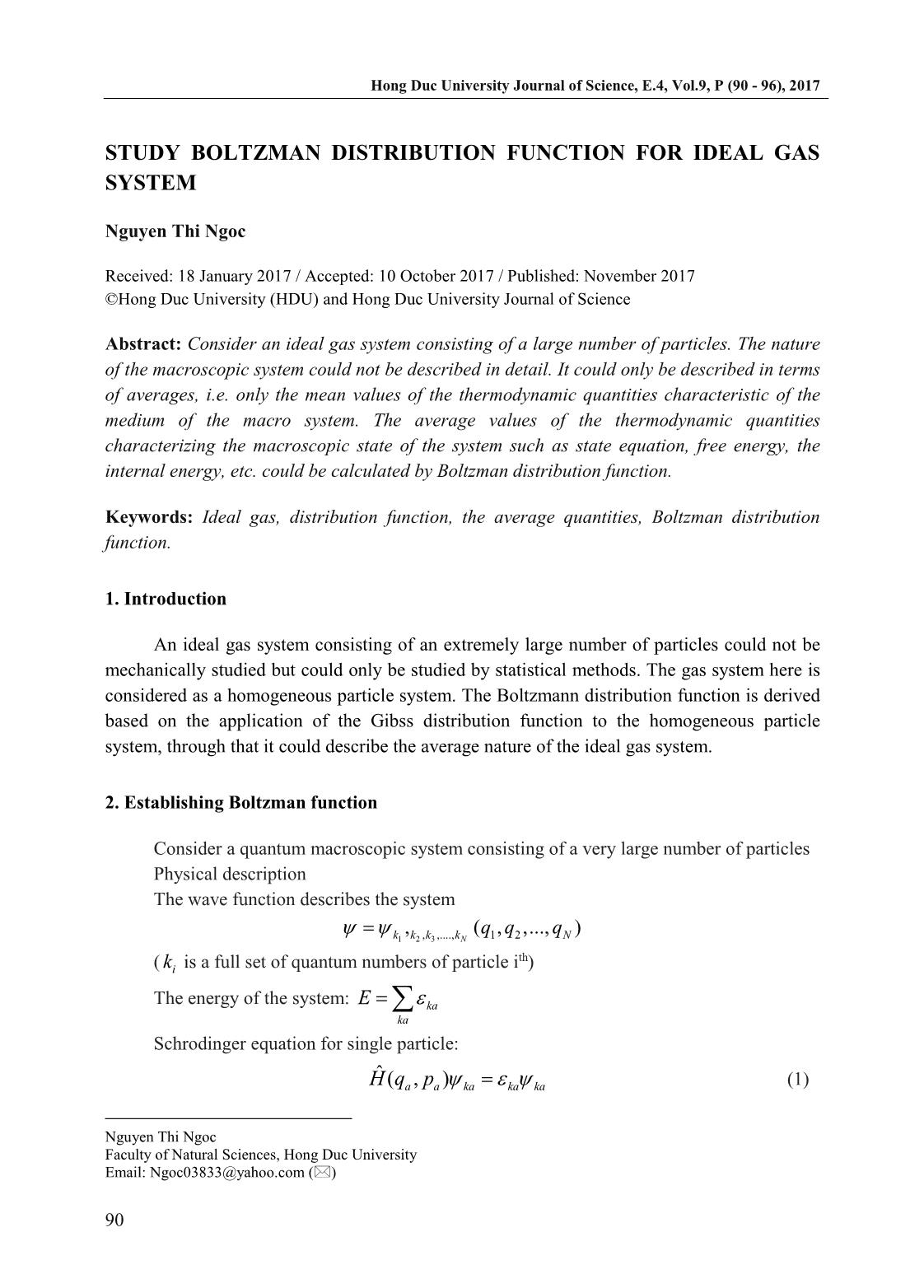
Trang 1
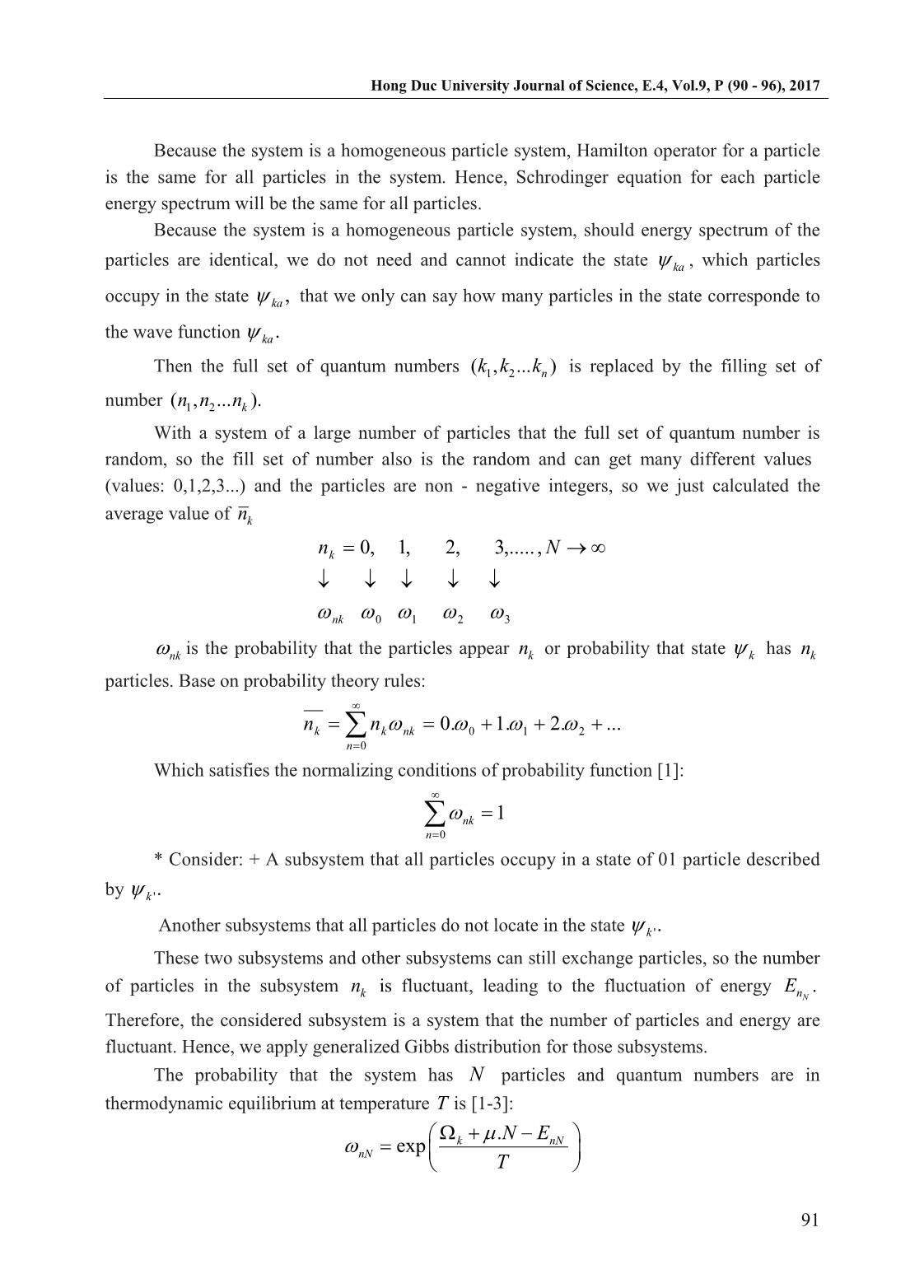
Trang 2
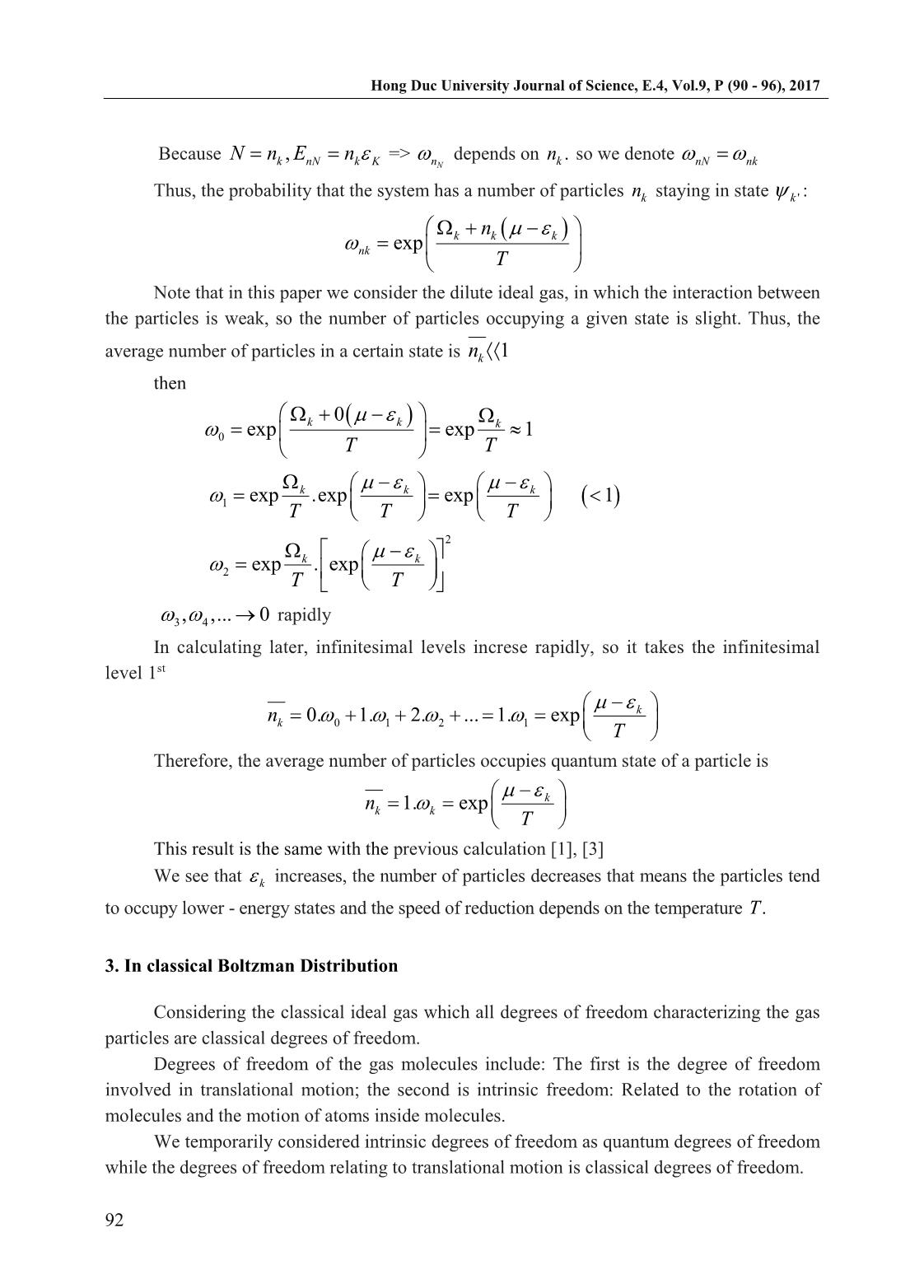
Trang 3
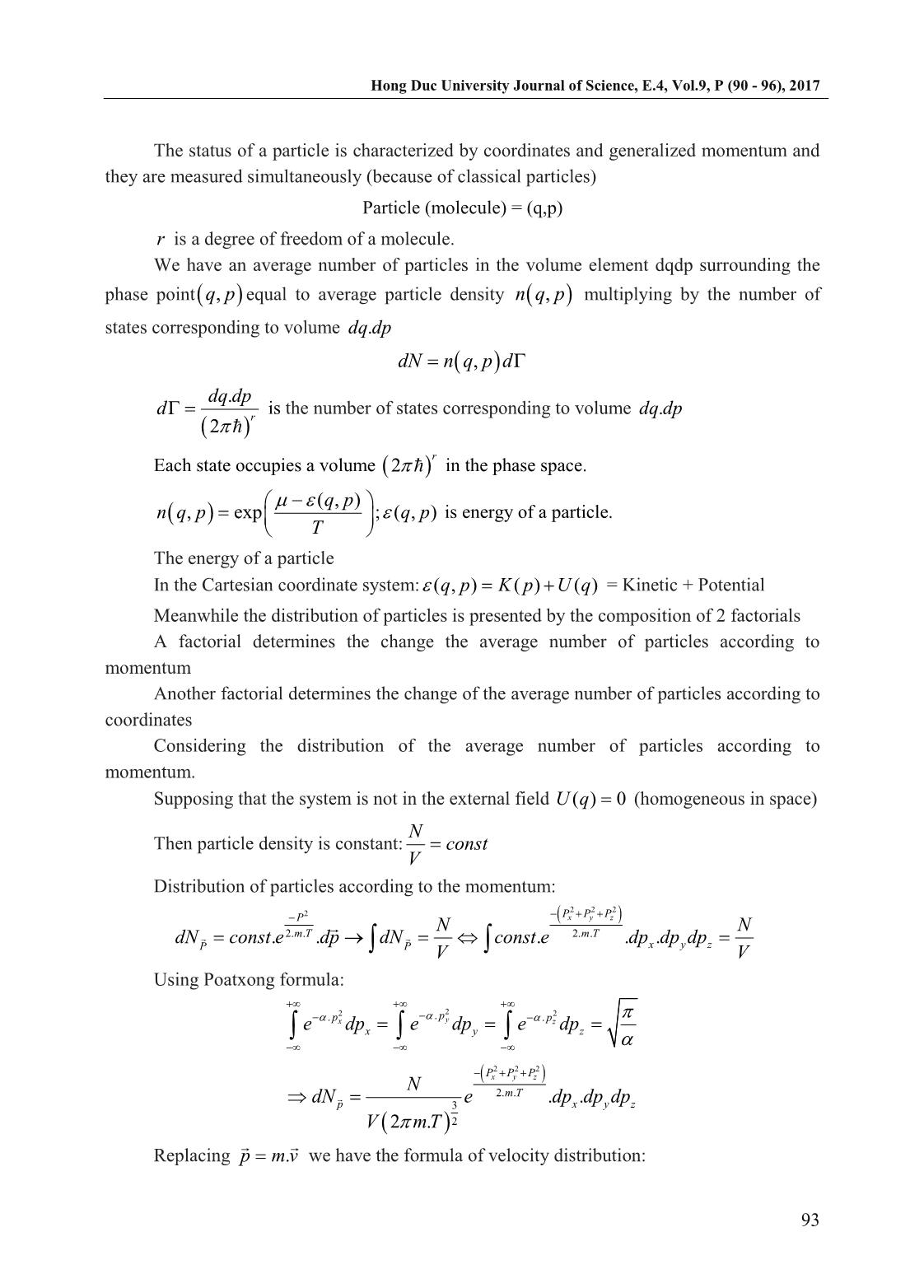
Trang 4
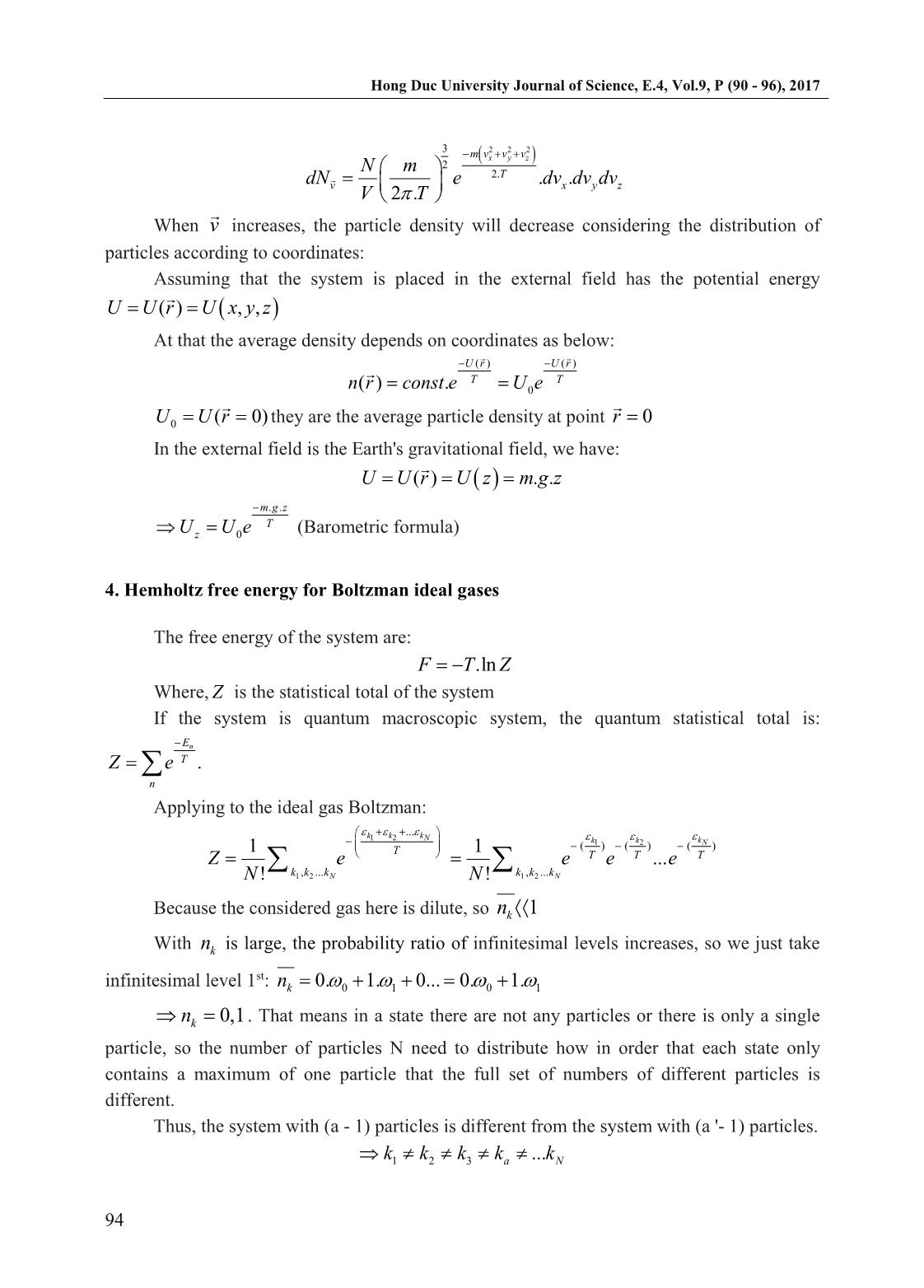
Trang 5
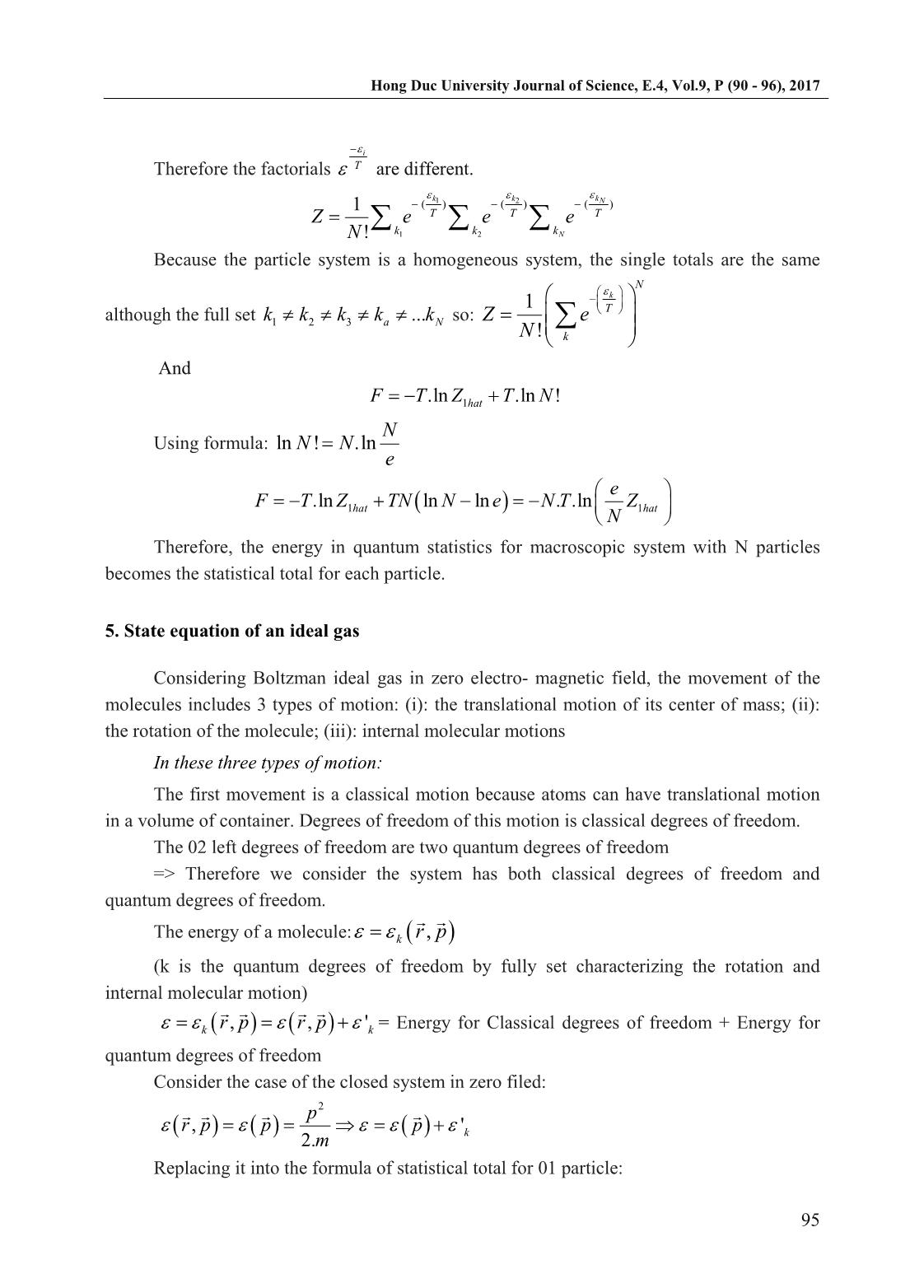
Trang 6
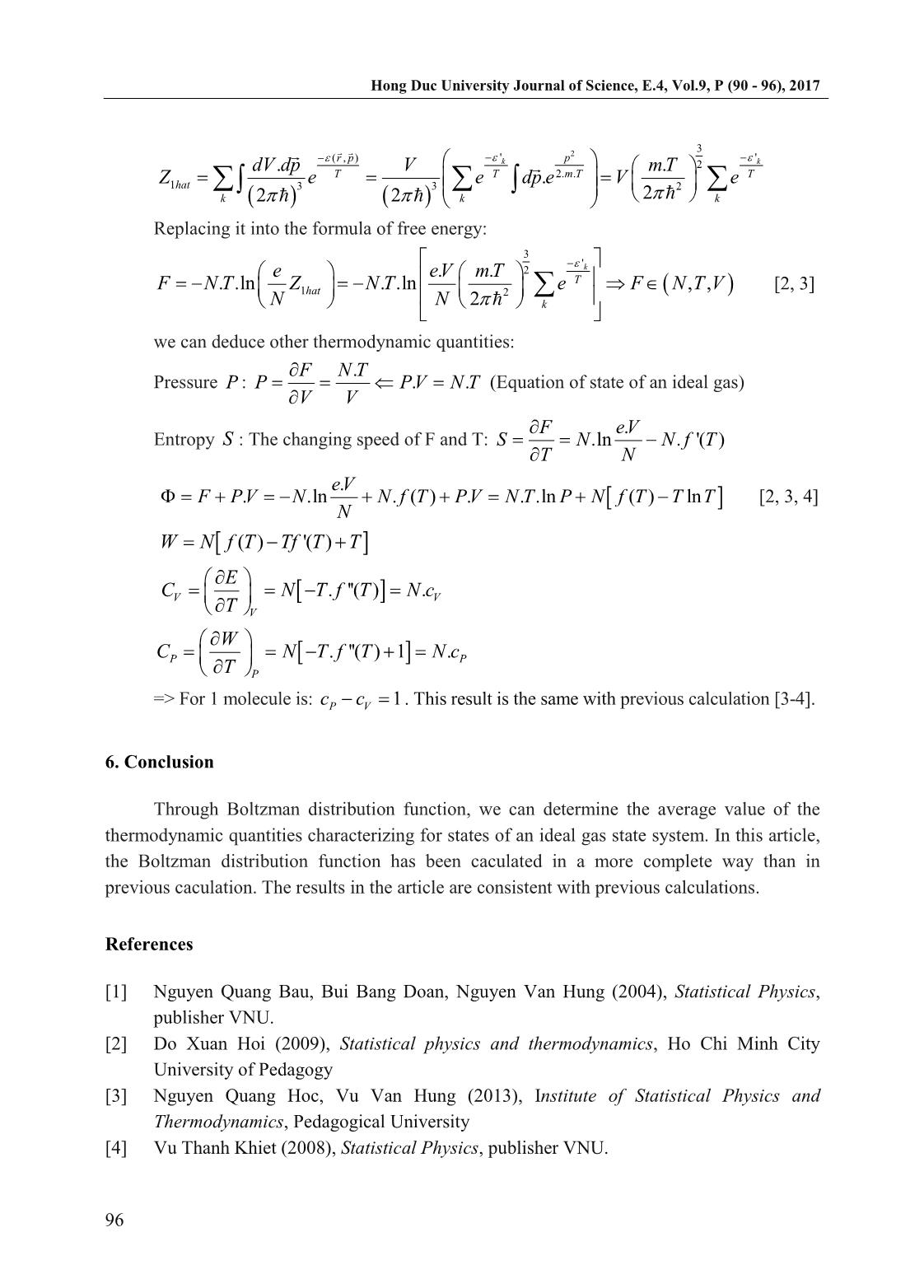
Trang 7
Tóm tắt nội dung tài liệu: Study boltzman distribution function for ideal gas system
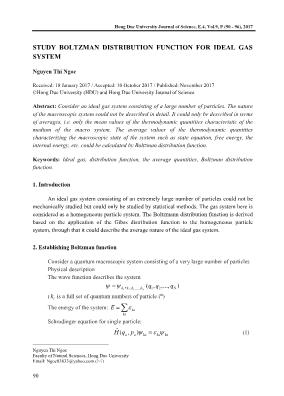
Hong Duc University Journal of Science, E.4, Vol.9, P (90 - 96), 2017 STUDY BOLTZMAN DISTRIBUTION FUNCTION FOR IDEAL GAS SYSTEM Nguyen Thi Ngoc1 Received: 18 January 2017 / Accepted: 10 October 2017 / Published: November 2017 ©Hong Duc University (HDU) and Hong Duc University Journal of Science Abstract: Consider an ideal gas system consisting of a large number of particles. The nature of the macroscopic system could not be described in detail. It could only be described in terms of averages, i.e. only the mean values of the thermodynamic quantities characteristic of the medium of the macro system. The average values of the thermodynamic quantities characterizing the macroscopic state of the system such as state equation, free energy, the internal energy, etc. could be calculated by Boltzman distribution function. Keywords: Ideal gas, distribution function, the average quantities, Boltzman distribution function. 1. Introduction An ideal gas system consisting of an extremely large number of particles could not be mechanically studied but could only be studied by statistical methods. The gas system here is considered as a homogeneous particle system. The Boltzmann distribution function is derived based on the application of the Gibss distribution function to the homogeneous particle system, through that it could describe the average nature of the ideal gas system. 2. Establishing Boltzman function Consider a quantum macroscopic system consisting of a very large number of particles Physical description The wave function describes the system , (q , q ,..., q ) k1 k 2, k 3 ,...., kN 1 2 N th ( ki is a full set of quantum numbers of particle i ) The energy of the system: E ka ka Schrodinger equation for single particle: ˆ H(,) qa p a ka ka ka (1) Nguyen Thi Ngoc Faculty of Natural Sciences, Hong Duc University Email: Ngoc03833@yahoo.com ( ) 90 Hong Duc University Journal of Science, E.4, Vol.9, P (90 - 96), 2017 Because the system is a homogeneous particle system, Hamilton operator for a particle is the same for all particles in the system. Hence, Schrodinger equation for each particle energy spectrum will be the same for all particles. Because the system is a homogeneous particle system, should energy spectrum of the particles are identical, we do not need and cannot indicate the state ka , which particles occupy in the state ka , that we only can say how many particles in the state corresponde to the wave function ka . Then the full set of quantum numbers (k1 , k 2 ... kn ) is replaced by the filling set of number (n1 , n 2 ... nk ). With a system of a large number of particles that the full set of quantum number is random, so the fill set of number also is the random and can get many different values (values: 0,1,2,3...) and the particles are non - negative integers, so we just calculated the average value of nk nk 0, 1, 2, 3,..... , N nk 0 1 2 3 nk is the probability that the particles appear nk or probability that state k has nk particles. Base on probability theory rules: nk nknk 0.0 1.1 2.2 ... n 0 Which satisfies the normalizing conditions of probability function [1]: nk 1 n 0 * Consider: + A subsystem that all particles occupy in a state of 01 particle described by k '. Another subsystems that all particles do not locate in the state k '. These two subsystems and other subsystems can still exchange particles, so the number of particles in the subsystem n is fluctuant, leading to the fluctuation of energy E . k nN Therefore, the considered subsystem is a system that the number of particles and energy are fluctuant. Hence, we apply generalized Gibbs distribution for those subsystems. The probability that the system has N particles and quantum numbers are in thermodynamic equilibrium at temperature T is [1-3]: k .NE nN nN exp T 91 Hong Duc University Journal of Science, E.4, Vol.9, P (90 - 96), 2017 Because N n, E n => depends on n . so we denote k nN k K nN k nN nk Thus, the probability that the system has a number of particles nk staying in state k ' : k n k k nk exp T Note that in this paper we consider the dilute ideal gas, in which the interaction between the particles is weak, so the number of particles occupying a given state is slight. Thus, the average number of particles in a certain state is nk 1 then k 0 k k 0 exp exp 1 TT k k k 1 exp .exp exp 1 TTT 2 k k 2 exp . exp TT 3, 4 ,... 0 rapidly In calculating later, infinitesimal levels increse rapidly, so it takes the infinitesimal level 1st k nk 0.0 1. 1 2. 2 ... 1. 1 exp T Therefore, the average number of particles occupies quantum state of a particle is k nk 1. k exp T This result is the same with the previous calculation [1], [3] We see that k increases, the number of particles decreases that means the particles tend to occupy lower - energy states and the speed of reduction depends on the temperature T. 3. In classical Boltzman Distribution Considering the classical ideal gas which all degrees of freedom characterizing the gas particles are classical degrees of freedom. Degrees of freedom of the gas molecules include: The first is the degree of freedom involved in translational motion; the second is intrinsic freedom: Related to the rotation of molecules and the motion of atoms inside molecules. We temporarily considered intrinsic degrees of freedom as quantum degrees of freedom while the degrees of freedom relating to translational motion is classical degrees of freedom. 92 Hong Duc University Journal of Science, E.4, Vol.9, P (90 - 96), 2017 The status of a particle is characterized by coordinates and generalized momentum and they are measured simultaneously (because of classical particles) Particle (molecule) = (q,p) r is a degree of freedom of a molecule. We have an average number of particles in the volume element dqdp surrounding the phase point q, p equal to average particle density n q, p multiplying by the number of states corresponding to volume dq. dp dN n q, p d dq. dp d is the number of states corresponding to volume dq. dp 2 r Each state occupies a volume 2 r in the phase space. (,)q p n q, p exp ; (,)q p is energy of a particle. T The energy of a particle In the Cartesian coordinate system: (,)()()q p K p U q = Kinetic + Potential Meanwhile the distribution of particles is presented by the composition of 2 factorials A factorial determines the change the average number of particles according to momentum Another factorial determines the change of the average number of particles according to coordinates Considering the distribution of the average number of particles according to momentum. Supposing that the system is not in the external field U( q ) 0 (homogeneous in space) N Then particle density is constant: const V Distribution of particles according to the momentum: 2 2 2 2 P PPPx y z NN dN const..... e2.m . T dp dN const e 2. m . T dp dp dp PP VV x y z Using Poatxong formula: 2 . p2 2 e . px dp ey dp e . pz dp x y z 2 2 2 PPPx y z N 2.m . T dNp 3 e.. dp x dp y dp z V 2 mT . 2 Replacing p m. v we have the formula of velocity distribution: 93 Hong Duc University Journal of Science, E.4, Vol.9, P (90 - 96), 2017 3 2 2 2 m vx v y v z N m 2 2.T dNv e.. dv x dv y dv z VT 2 . When v increases, the particle density will decrease considering the distribution of particles according to coordinates: Assuming that the system is placed in the external field has the potential energy U U(),, r U x y z At that the average density depends on coordinates as below: U()() r U r TT n(). r const e U0 e U0 U( r 0) they are the average particle density at point r 0 In the external field is the Earth's gravitational field, we have: U U().. r U z m g z m.. g z T Uz U0 e (Barometric formula) 4. Hemholtz free energy for Boltzman ideal gases The free energy of the system are: FTZ .ln Where, Z is the statistical total of the system If the system is quantum macroscopic system, the quantum statistical total is: En Z e T . n Applying to the ideal gas Boltzman: k k ... k 1 2 N k k k 1 1 ()()()1 2 N Z e T eTTT e... e N! k1, k 2 ... kN N! k1, k 2 ... kN Because the considered gas here is dilute, so nk 1 With nk is large, the probability ratio of infinitesimal levels increases, so we just take st infinitesimal level 1 : nk 0.0 1. 1 0... 0. 0 1. 1 nk 0,1. That means in a state there are not any particles or there is only a single particle, so the number of particles N need to distribute how in order that each state only contains a maximum of one particle that the full set of numbers of different particles is different. Thus, the system with (a - 1) particles is different from the system with (a '- 1) particles. k1 k 2 k 3 ka ... k N 94 Hong Duc University Journal of Science, E.4, Vol.9, P (90 - 96), 2017 i Therefore the factorials T are different. k k k 1 ()()()1 2 N Z eTTT e e N! k1 k 2 kN Because the particle system is a homogeneous system, the single totals are the same N k 1 although the full set k k k k ... k so: Z e T 1 2 3 a N N ! k And FTZTN .ln1hat .ln ! N Using formula: lnNN ! .ln e e F T.ln Z1hat TN ln N ln e N . T .ln Z 1 hat N Therefore, the energy in quantum statistics for macroscopic system with N particles becomes the statistical total for each particle. 5. State equation of an ideal gas Considering Boltzman ideal gas in zero electro- magnetic field, the movement of the molecules includes 3 types of motion: (i): the translational motion of its center of mass; (ii): the rotation of the molecule; (iii): internal molecular motions In these three types of motion: The first movement is a classical motion because atoms can have translational motion in a volume of container. Degrees of freedom of this motion is classical degrees of freedom. The 02 left degrees of freedom are two quantum degrees of freedom => Therefore we consider the system has both classical degrees of freedom and quantum degrees of freedom. The energy of a molecule: k r, p (k is the quantum degrees of freedom by fully set characterizing the rotation and internal molecular motion) k r,,' p r p k = Energy for Classical degrees of freedom + Energy for quantum degrees of freedom Consider the case of the closed system in zero filed: p2 r,' p p p 2.m k Replacing it into the formula of statistical total for 01 particle: 95 Hong Duc University Journal of Science, E.4, Vol.9, P (90 - 96), 2017 3 (,)r p ''p2 dV.. dp V k mT 2 k Z eTTT e dp. e2.m . T V e 1hat 3 3 2 k2 2 k 2 k Replacing it into the formula of free energy: 3 ' e eV.. mT 2 k T FNT . .ln Z1hat NT . .ln 2 e FNTV , , [2, 3] NN 2 k we can deduce other thermodynamic quantities: FNT. Pressure P : PPVNT .. (Equation of state of an ideal gas) VV F eV. Entropy S : The changing speed of F and T: S N.ln N . f '( T ) TN eV. FPV . N .ln NfT .() PVNTPNfTTT . ..ln () ln [2, 3, 4] N W N f( T ) Tf '( T ) T E CVV N T. f ''( T ) N . c T V W CPP N T. f ''( T ) 1 N . c T P => For 1 molecule is: cPV c 1. This result is the same with previous calculation [3-4]. 6. Conclusion Through Boltzman distribution function, we can determine the average value of the thermodynamic quantities characterizing for states of an ideal gas state system. In this article, the Boltzman distribution function has been caculated in a more complete way than in previous caculation. The results in the article are consistent with previous calculations. References [1] Nguyen Quang Bau, Bui Bang Doan, Nguyen Van Hung (2004), Statistical Physics, publisher VNU. [2] Do Xuan Hoi (2009), Statistical physics and thermodynamics, Ho Chi Minh City University of Pedagogy [3] Nguyen Quang Hoc, Vu Van Hung (2013), Institute of Statistical Physics and Thermodynamics, Pedagogical University [4] Vu Thanh Khiet (2008), Statistical Physics, publisher VNU. 96
File đính kèm:
 study_boltzman_distribution_function_for_ideal_gas_system.pdf
study_boltzman_distribution_function_for_ideal_gas_system.pdf

